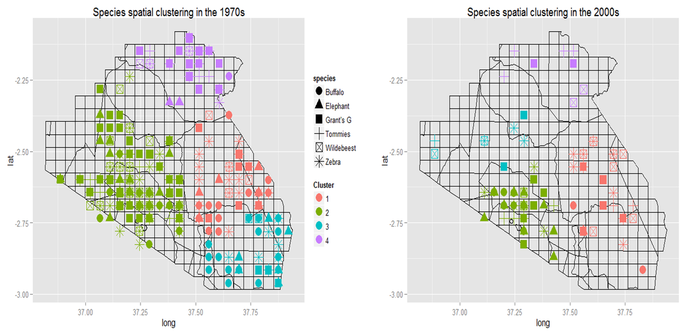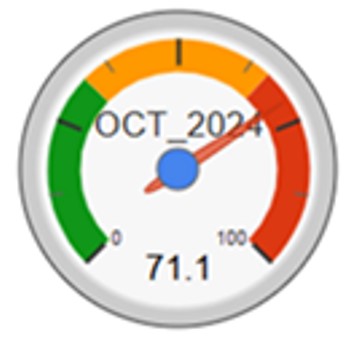The spatial contraction of the Amboseli ecosystem is worrying, based on an analysis of the long-term counts dating back to 1973. Victor Mose, who attended a special workshop on spatial modeling in ecology held in Birmingham UK in June (watch video below), has been developing visualization tools to distill and illustrate the extent of spatial change in species distributions.

The provisional maps (Figure 1) are based on six key species. The results illustrate a strong contraction in the spatial spread and richness of species in the four main clusters of wildlife populations identified by spatial clustering techniques. Regaining the spatial connections is important for the health and richness of the ungulate and carnivore populations will be the focus of land use plans ACP will draw up with AET in the coming few months.
The spatial contraction of the Amboseli ecosystem is worrying, based on an analysis of the long-term counts dating back to 1973. Victor Mose, who attended a special workshop on spatial modeling in ecology held in Birmingham UK in June (watch video below), has been developing visualization tools to distill and illustrate the extent of spatial change in species distributions.

The provisional maps (Figure 1) are based on six key species. The results illustrate a strong contraction in the spatial spread and richness of species in the four main clusters of wildlife populations identified by spatial clustering techniques. Regaining the spatial connections is important for the health and richness of the ungulate and carnivore populations will be the focus of land use plans ACP will draw up with AET in the coming few months.
The spatial contraction of the Amboseli ecosystem is worrying, based on an analysis of the long-term counts dating back to 1973. Victor Mose, who attended a special workshop on spatial modeling in ecology held in Birmingham UK in June (watch video below), has been developing visualization tools to distill and illustrate the extent of spatial change in species distributions.

The provisional maps (Figure 1) are based on six key species. The results illustrate a strong contraction in the spatial spread and richness of species in the four main clusters of wildlife populations identified by spatial clustering techniques. Regaining the spatial connections is important for the health and richness of the ungulate and carnivore populations will be the focus of land use plans ACP will draw up with AET in the coming few months.
The spatial contraction of the Amboseli ecosystem is worrying, based on an analysis of the long-term counts dating back to 1973. Victor Mose, who attended a special workshop on spatial modeling in ecology held in Birmingham UK in June (watch video below), has been developing visualization tools to distill and illustrate the extent of spatial change in species distributions.

The provisional maps (Figure 1) are based on six key species. The results illustrate a strong contraction in the spatial spread and richness of species in the four main clusters of wildlife populations identified by spatial clustering techniques. Regaining the spatial connections is important for the health and richness of the ungulate and carnivore populations will be the focus of land use plans ACP will draw up with AET in the coming few months.
For over 50 years, we’ve been pioneering conservation work in Amboseli sustained habitats, livelihoods and resilience through collaboration amid environmental changes, protecting biodiversity.
Current grazing pressure percentage.

Amboseli Conservation Program
P.O Box 15289-00509 or 62844-00200
Nairobi, Kenya.
Tel/Fax: +254 20 891360 / 891751
Email: acc@acc.or.ke
Amboseli Conservation Program
P.O Box 15289-00509 or 62844-00200
Nairobi, Kenya.
Tel/Fax: +254 20 891360 / 891751
Email: acc@acc.or.ke